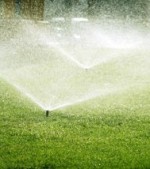 Watering is one of the most important factors in maintaining a healthy and attractive lawn. Unfortunately, the amount of water a lawn needs to thrive depends on many variables and must be adjusted on a regular basis to fit the circumstances. Irrigating a lawn is not something you can set for the season and continue in the same mode from spring until fall.
Watering is one of the most important factors in maintaining a healthy and attractive lawn. Unfortunately, the amount of water a lawn needs to thrive depends on many variables and must be adjusted on a regular basis to fit the circumstances. Irrigating a lawn is not something you can set for the season and continue in the same mode from spring until fall.
Here are six variables that will determine the amount of water that a lawn needs.
Soil: There are three main types of soil and they vary in the amount of water they can absorb and hold as well as how quickly they dry out.
 Sandy Water enters sandy soils quickly and runs quickly through them so they dry out quickly. Lawns growing on sandy soil need more frequent watering than lawns growing on other kinds of soil.
Sandy Water enters sandy soils quickly and runs quickly through them so they dry out quickly. Lawns growing on sandy soil need more frequent watering than lawns growing on other kinds of soil.
 Clay Clay soils are slow to absorb water and hang on to it. The water may not penetrate deeply and the soil may dry out slowly. Lawns on clay soils need less frequent water but they should be deep and the water given time to sink in.
Clay Clay soils are slow to absorb water and hang on to it. The water may not penetrate deeply and the soil may dry out slowly. Lawns on clay soils need less frequent water but they should be deep and the water given time to sink in.
 Loam The idea soil for grasses is a loam. Loams absorb water easily and retain moisture while allowing access water to drain away.
Loam The idea soil for grasses is a loam. Loams absorb water easily and retain moisture while allowing access water to drain away.
Climate: Heat, sunshine, humidity, and wind play a big role in determining lawns’ needs for water. Bright sun, heat, and wind cause grasses and soil to dry out more quickly than overcast skies, low temperatures, and little air movement. High humidity also decreases a lawn’s need for water but has unpleasant consequences for fungal disease development which can influence watering regimes.
Type of Grass: Some grasses need more water than others; some will go dormant when water is in short supply while others like Kentucky Bluegrass can not survive drying out. In general, warm-season grasses like Bermuda grass can tolerate lower water levels than cool-season grasses like fescue.
Competition from Other Plants: Grass growing under a tree has to compete with the tree for water and the tree will usually win. Big trees have bigger roots than small trees and require more water. Even though grass growing in a shady areas needs less water than one growing in full sun, if another plant takes a lot of the water, more water must be applied.
Mowing Height: Grasses that are mown short need more water than the same grass allowed to grow longer.
Fertilizing Regime: The application of fertilizer, especially those with high nitrogen, make the grass grow faster and the faster growth requires more water.
Lawns need adequate water to be healthy and look well. Too much water can be as bad or worse than not enough so it is very important to determine the lawn’s need on a regular basis. There is a certain amount of trial and error that is necessary and mistakes are inevitable, but lawns are somewhat forgiving in regard to short term mistakes. For specific advice on your soil and grass variety, consult your county extension agent.
